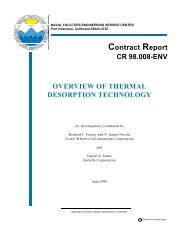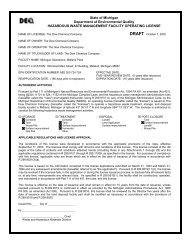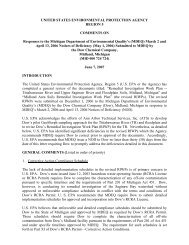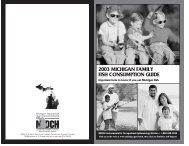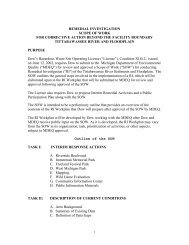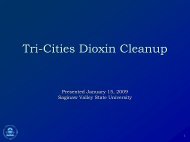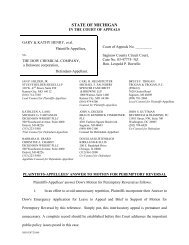EPA memo - Tittabawassee River Watch
EPA memo - Tittabawassee River Watch
EPA memo - Tittabawassee River Watch
- No tags were found...
Create successful ePaper yourself
Turn your PDF publications into a flip-book with our unique Google optimized e-Paper software.
.,:~.;. ,'..~. ;,",.~:~.~-i--.~~\~=~)"~oS'. UNITED STATES ENVIRONMENTAL PROTECTION AGENCY '-:-. ~;:l ;~:.~ --~ REGIONS.~ ~/1 ~ 77 WEST JACKSON BOULEVARD\~~ ~~ CHICAGO, IL 60604-3590 ~ '" .A"'I: ..Gv PO"'i( PRO\~ c' .NOY 0 8 2004 ~,REPL Y TO THE ATTENTION OFLes E. WeigumCELRE-PL-EU.S. Army COrpS of Engineers, Detroit DistrictP.O. Box 1027Detroit, Michigan 48231-1027B-19JRe: Comments on U.S. Army Corps, of Engineers July 2004 Phase IIReport-Draft Dredged Material Management Plan and EnvironmentalAssessment-Dredged Material Disposal Facility, Saginaw and Bay,- Counties, MichiganDear Mr. Weigum:The U.S. Environmental Protection Agency, Region 5 (U.S. <strong>EPA</strong> or the Agency)has reviewed the U.S. Army Corps of Engineers, Detroit District's (Corps) July 2004,':Phase II Report-Draft Dredged Material Management Plan and EnvironmentalI":Assessment-Dredged Material Disposal Facility, Saginaw and Bay Counties, Michigan1:1 (DEA). The DEA evaluates alternatives for disposing dredged material from federal! 1J navigation channels in the upper Saginaw <strong>River</strong> (Michigan). According to the DEA,~~ ? there is a need to dispose of over 3 million cubic yards of dredged material from the river"Ci:*over a 20-year period.:7":Initially, the Corps established a June 19, 2004 deadline for public comment on thei~ DE A; however, the Corps extended this deadline to November 8,2004, because U.S. EP A,, did not receive the DEA during the initial comment period. The Agency now providesits comments on the DEA in accordance with the National Environmental(N<strong>EPA</strong>).In summary, U.S. <strong>EPA</strong> provides the following comments on the DEA:(1) dioxin contaminated sediments,(2) PCB contaminated sediments,(3) integrity of the dredged material disposal facility during flood events,(4) effluent monitoring and mitigation plan, and(5) endangered speciesPolicy ActAs you know, the Michigan Department of Environmental Quality (MDEQJs~Glt~~sMaterials Division..NOV122004Recycled/Recyclable'Printed with Veqetable 011 Based Inks on 50% Recv
,Chemical Company (Dow Chemical) are currently negotiating an approach to addressdioxin contamination in the <strong>Tittabawassee</strong> and Saginaw <strong>River</strong> watersheds. We strongly~ encourage the Corps to coordinate its dredging efforts with U.S. <strong>EPA</strong> and MDEQ,particularly in light of any agreements that MDEQ may reach with Dow Chemical.2Based upon these comments, U.S. <strong>EPA</strong> recommends that the Corps not sign a Findingof No Significant Impact (FaNSI) for this project until these issues are resolved to theAgency's satisfaction. U.S. <strong>EPA</strong>'s comments are enclosed.Finally, the DEA incorrectly states that U.S. EP A did not respond with commentson the draft dredged material disposal plan, when the Corps solicited comments duringan earlier scoping stage. For your information, we have also enclosed a copy of a May5, 2003 comment letter previously submitted by the Agency to Corps for the proposedproject.Thank you for the opportunity to review and provide comments on the DEA. If youhave any questions or comments, please feel free to contact me at (312) 886-2910, or thefollowing staff:1. Newton Ellens, for general N<strong>EPA</strong> issues, at (312) 353-5562,2. John Steketee, for legal issues, at (312) 886-0558,3. Gregory Rudloff, for dioxin contamination issues, at (312) 886-0455,4. David Petrovski, for sediment issues, at (312) 886-09975. Anton Martig, for PCB contamination issues, at (312) 353-2291, and6. Ashfaq Sajjad, for effluent monitoring and mitigation issues, at (312) 886-6112.Sincerely yours,? /' h-:/ «,.,. ~ // ,~~/--~,~'. Kenneth /, Westlake, .-'~'f '7 I ..,-' ,r~(C~;!!~Chief (..'---{EnvironmentalPlanning and Evaluation BranchEnclosurescc: Cheryl Howe, Michigan Department of Environmental QualityAI Taylor, Michigan Department of Environmental QualityBen Baker, Dow Chemical CompanyDavid Gustafson, Dow Chemical Company--. ,-~ -;"(\~'~"-
"j ." f .,J~(--ATTACHMENTComments on U.S. Armv COrDS of Enaineers Julv 2004 Phase II Renort-DraftDredaed Material Manaaement Plan and Environmental Assessment-DredgedMaterial Disnosal Facilitv. Saainaw and Bav Counties. MichiganA. Dioxin-Contaminated SedimentsNovember 8, 2004.1. U.S. EP A believes that the overall remedial objectives for the <strong>Tittabawassee</strong>and Saginaw Watershed need to be carefully considered by U.S. Army Corps ofEngineers' (Corps') when developing its dredging plans for the upper Saginaw <strong>River</strong>.Despite supporting the maintenance of navigation depths on the upper Saginaw <strong>River</strong>,U.S. EP A has significant concerns regarding the impact the Corps' project, as proposed,will have upon the remediation objectives for the basin as a whole.2. The Saginaw <strong>River</strong> is a significant source of dioxin to the Great Lakes. Thesediments within the watershed, as well as floodplain soils, are highly contaminated,- with dioxins and furans. Much, if not all, of this contamination is thought to haveoriginated in Midland, Michigan. Throughout much of the twentieth century, hydraulicforces within the watershed have dispersed these contaminants downstream throughoutthe <strong>Tittabawassee</strong> and Saginaw <strong>River</strong> Watershed. Currently dioxin and furancontaminated sediments can be found extending into Lake Huron. The sedimenttransport mechanisms which have resulted in the current distribution of thecontamination continue unabated. U.S. <strong>EPA</strong> believes that maintaining navigationaldepths on the river will help to mitigate the migration of contaminant sedimentsdownstream and into Saginaw Bay. Dredging will result in the removal of somecontaminated sediments, which serve as continuing sources of dioxin to the watershed.Also, dredged areas may act as a sediment sinks, which may impede the migration ofcontaminated sediments downstream. -3. U.S. <strong>EPA</strong>would like to encourage the Corps to consider over-dredging asection of the navigation channel to enhance the sediment settling effects associatedwith a maintained navigation channel. This over -dredged section would function as asediment trap to minimize the migration of dioxin contaminated sediments into Saginaw.Bay. U.S. <strong>EPA</strong> would like to be involved in the design and monitoring of any suchsediment trap in order to gather information which could be used in other portions of thewatershed...Agency4. U.S. EP A has significant concerns regarding the Corps proposal toselectively dredge around areas of sediment with elevated dioxin concentrations. Thebelieves this type of selective dredging will likely leave sediments, with highlyelevated concentrations of dioxin, in or near the upper Saginaw <strong>River</strong> navigation channel,
. .~in a very unstable position. U.S. EP A believes that the reduced stability of these areaswill greatly increase the migratory potential of these highly contaminated sediments.£ This would ultimately lead to the dispersal of these sediments downstream, pose further2challenges for downstream remediation and further contaminate the ecosystem.Accordingly, the Agency requests that the Corps provide documentation under theNational Environmental Policy Act (N<strong>EPA</strong>) to U.S. <strong>EPA</strong> sufficiently and adequatelyaddressing how the Corps intends to address the stability of the highly contaminatedsediments in the upper Saginaw <strong>River</strong>.5. U.S. EP A strongly encourages the Corps to work with the MichiganDepartment of Environmental Quality (MDEQ), Dow Chemical Company, and any otherparty responsible for the dioxin contamination in the upper Saginaw <strong>River</strong> sediments,to develop a coordinated and systematic plan to remove any highly contaminatedsediments in the upper Saginaw <strong>River</strong> in a manner which will protect human health andthe environment. The Agency is willing and available to provide any support necessaryto the Corps to ensure a responsible and practical solution to this issue.iJ6. U.S. <strong>EPA</strong> believes that, with certain exceptions addressed below, theproposed Confined Disposal Facility (CDF) is designed to adequately address theenvironmental concerns associated with the disposal of sediments contaminated withlow concentrations of dioxins. However, the CDF is not an appropriate location for thedisposal of sediments contaminated with high concentrations of dioxins. As a result,U.S. EP A believes that the Corps should develop and define, in coordination with MDEQand U.S. EP A, a threshold concentration for sediment management and disposal in thisproject.Under such a threshold, sediments with contaminant levels above the thresholdwould be sent for disposal to a facility that would provide a higher level of environmentalisolation and protection. This concentration threshold could be developed through astatistical method or approach. For example, this method or approach could based upona confidence limit or other generally accepted method. Appropriate treatment and/ordisposal option(s) for the sediments found to have dioxin concentrations above thethreshold will need to be determined in conjunction with the State of Michigan and U.S.EP A. The Corps in turn would be responsible for evaluating the cost increasesassociated with the selected disposal alternatives for the sediment with elevatedcontaminant levels. Agreement upon this issue would allow sediments with higherconcentrations of dioxins to be dredged sequentially with their lower level counterparts.Accordingly, the Agency requests that the Corps provide NEP A documentationto U.S. EP A which sufficiently and adequately addresses how the Corps intends tomanage and dispose of sediments contaminated with high concentrations of dioxinsfrom the upper Saginaw <strong>River</strong>. In addition, no final decision on a thresholdconcenttationshould be made with out..written approval of MDEQ and U.s. <strong>EPA</strong>.,18!i1';~f
3B. PCB-Contaminated SedimentsU.S. EP A is concerned about PCB concentrations in the upper Saginaw <strong>River</strong>sediments because the DEA does not include adequate information on thecharacterization of the levels of PCB contamination in the sediments. The requiredremediation depends on the level of PCB contamination:1. Low levels of PCB contamination (under 50 ppm)The levels of contamination should be substantiated with appropriate andqualified characterization sampling and analysis. The sediments containing under 50ppm could be managed or disposed of in accordance with a permit issued under Section404 of the Clean Water Act; a permit issued under Section 103 of the Marine Protection,Research, and Sanctuaries Act; or in accordance with the equivalent of such permitsprovided for in U.S. Army Corps of Engineers regulations 33 CFR Part 320.2. High levels of PCB contamination (at or over 50 ppm).) If the concentration of PCBs in the sediment is found to be at concentrations of50 ppm or greater or it is detemlined that the sediment must be managed as such, then; separate approval under the Toxic Substances Control Act (TSCA), and the Federal PCBregulations (at 40 CFR Part 761) for the remediation and disposal of the sediment wouldbe necessary. Such an approval would have to be issued by U.S. <strong>EPA</strong>.Accordingly, U.S. <strong>EPA</strong> requests the Corps to issue subsequent N<strong>EPA</strong>documentation that includes information on the adequate characterization of the levelsof PCB contamination in the sediments, and describes the planned remediation activitiesfor these sediments with regard to comments B.1 and B.2, above..--C. Integritv of DredGed Material DisDosal Facilitv DurinG Flood Events --Based upon U.S. EP A's review of the engineering specifications for the Alternative# 1 Dredged Material Disposal Facility (DMDF), the proposed height of the containmentdikes surrounding the facility do not appear to be high enough to withstand routine floodevents on the Saginaw <strong>River</strong>. As proposed, the elevation of the dikes (591 feet) is only14 feet above the October 2004 elevation of the Saginaw <strong>River</strong> (577 feet) at the Zilwaukee<strong>River</strong> Bridge. Accordingly, any flood event over fourteen (14) feet could impact theintegrity of the DMDF and could result in a significant release of contaminants to theSaginaw <strong>River</strong>...Therefore, befQre issuing a Finding of No Significant Impact (fONSI) for thisproject, U.S. EP A requests that the Corps provide the Agency with NEP A docwnentation'\-~.
J ~. , r- ,-0\.~4\ ~ which: (1) summarizes the basis for the Corps' determination that the proposed height) -'! .of the containment dikes is adequate to withstand routine flood events, and (2) evaluatesthe risk of flood events impacting the integrity of the DMDF.D. Effluent Monitorina and Mitiaation Plan to Address Possible Release ofContaminants to the Saginaw <strong>River</strong> from Outlet WeirThe DEA states that effluent will be discharged from the DMDF to the Saginaw<strong>River</strong> through the proposed weir only if monitoring of the weir shows compliance withapplicable Michigan water quality standards, and, therefore, the proposed effluentshould not violate water quality standards. However, the DEA does not include aproposed effluent monitoring and mitigation plan (EMMP), nor does the DEA describethe proposed monitoring methods, location, and frequency, or what remedial action willbe taken should the effluent nQt. meet water quality standards..Accordingly, U.S. <strong>EPA</strong> cannot provide final comments on the EMMP at this time;- and reserves its right to comment on the EMMP once it has been completed andprovided to the Agency by the Corps for a qualitative review. Accordingly, U.S. <strong>EPA</strong>requests that the Corps provide the Agency with a copy of the Corps' application toMDEO for water quality certification under Section 401 of the Clean Water Act. Thisshould include, but not necessarily be limited to, a copy of the DMDF effluent monitoringand mitigation plan, in order for U.S. EP A to determine compliance with Michigan waterquality standards.E. Endangered SpeciesThe Corps states in the DEA that a preliminary determination has been made thatthe proposed project would not affect the bald eagle, and that consultation with U.S.Fish & Wildlife Service (U.S. FWS) has been initiated. U.S. <strong>EPA</strong> appreciates the Corps'efforts to coordinate with U.S. FWS on this issue. However, the Corps provides nofactual basis in the DEA for its statement that the project would not impact the b~deagle. U.S. FWS consultation should be satisfactorily completed before the Corps signsa FONSI for the proposed project. The FONSI should document the results of theconsultation with U.S. FWS.G. ConclysionIn conclusion, U.S. <strong>EPA</strong> requests that the Corps delay issuing a FONSI in thismatter until issues we raise in this letter are adequately addressed.i . ., ..j'" -."~~?:;;~;'::;c--,;
~~E.D Sr-4~!),"~~ It. \1':" UNITED STATES ENVIRONMENTAL PROTECTION AGENCY~ ~ '! REGION 5~~"""J:~#~ 77 WESTCHICAGO.JACKSONIL 60604-3590BOULEVARD.'il PRO~~-:- MAY 0 5 2003 -AEPL Y TO THE ATTENTION OFB-19JLes E. WeigurnCELRE-PL-EU.S. Anny COrpS of Engineers, Detroit DistrictP.o. Box 1027Detroit, Michigan 48231-1027Re:Scoping Comments fox the Evaluation of Potential Alternatives for DisposingDredged Material from the Upper Saginaw <strong>River</strong>Dear Mr. Weigum:The U.S. Environmental Protection Agency (U.S. <strong>EPA</strong>) has reviewed an April 7, 2003 scopingletter from the U.S. Anny Corps ofP,ngineers (Corps); the letter provides a summary of possiblealternatives for disposing dredged material from federal navigation channels in the upperSaginaw <strong>River</strong>. Under the Corps' Dredged Material Management Plarl., there is a need to disposeof o'rer 3 million cubic yards of dredged material from the river over a 20-yeax: period. AnEnvironmental Assessment (EA) will be developed by the Corps to evaluate possible impactsfrom the feasible alternatives. We are providing comments on the Corps' scoping letter inaccordance with the National Environmental Policy Act.Weare concerned because the proposed project is located in the Saginaw <strong>River</strong>. The Saginaw<strong>River</strong> and Saginaw Bay is one of a number of Areas of Concern (AOC) listed in the Great LakesWater Quality Agreement (GLWQA). GLWQA is an international agreement intended toaddress the most polluted areas in the Great Lakes. A Remedial Action Plan (RAP) develope~for the Saginaw <strong>River</strong> and Bay currently identifies 11 beneficial use impairments for the AOC.TheEA should include an evaluation of the following potential dredging impacts, which mayaggravate certain beneficial use impainnents for the Saginaw <strong>River</strong> and Bay. For each potentialimpact, the EA should include an associated mitigation plan.1. Disturbance of Contaminated Sediments. The EA should evaluate the impact of dredgingactivities in areas with contaminated sediment. The evaluation should account for PCBand dioxin-contaminated sediment. Sediment contamination in the river is mostsignificant immediately downstream of Saginaw and Bay City. These sediments canrelease toxics and nutrients into the water if disturbed by dredging activities. Weunderstand t~at, according to the Corps' scoping letter, sediment samples collected fromSaginaw <strong>River</strong> in 1999 contained non-detectable levels of PCBs. The-EA should include,Recycled/Recyclable. "rinted with Vegetable Oil Based Inks on 100% Recycled Paper (50% Postconsumer)c'.-,. ,",:cc.'.", -, -
" ..2an analysis of dioxins in the Saginaw <strong>River</strong> sediment, and forecast PCB and dioxin levels,in the sediment for the project's 20-year duration. The EA should account for subsequentimpacts from dredging activities.2. Destruction of Fish Habitat. Dredging may destroy fish habitat by removing the riverbottom substrate. The EAshould describe the present fish populations and habitat in the.federal navigation channe.is; and evaluate the dredging project's impact on the habitat andfish populations. ...3. Introduction of Invasive SQecies. The EA should evaluate the impact of potentiallyintroducing invasive species to the Saginaw <strong>River</strong> and Bay through dredging activities.Recently, Saginaw Bay was colonized by zebra mussels. This has the potential tosignificantly impact biological communities and contaminant cycling in the bay. The EAshould describe the present invasive species populations in the Saginaw <strong>River</strong> andevaluate potential impacts of invasive- species introduced through dredging activities..Thank you for the opportunity to review and provide comments on the scoping document. Pleaseprovide our office with a copy of the upcoming EA. If you have any questions or comments,please feel free to contact Newton Ellens, of-my staff, at (312) 353-5562..,. .S~~:":d~E- .f- Kenneth Westlake, ChiefEnvironmental Planning ~d Evaluation Branch.~. ..._.~'-' '-"-- ~-. , j'i~;:"':7""_-~~-



